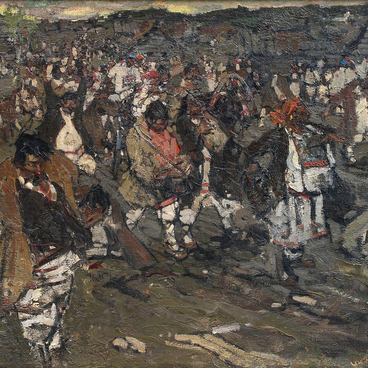Sketches for the painting “Cheremis Wedding” occupy a special place in the work of the artist Nikolai Ivanovich Fechin. The simple, multilingual and colorful life of the peoples of the Volga region, which he had known since childhood, became an integral part of his work.
While still a student at the Kazan Art School, Nikolai Fechin visited his aunt and uncle on weekends. His father’s brother owned a turpentine factory in the village of Kushnya, a hundred miles from Kazan. The settlement was located amidst dense forests and the Cheremis people who lived there were practically unaffected by progress and civilization.
The Cheremis were the former name of the Mari, a Finno-Ugric ethnic group who mainly live in the Republic of Mari El and in the north of the Republic of Bashkortostan. The artist observed the traditions and everyday life of these people, as well as their beliefs with ancient pagan deities and rituals.
The wedding ritual, depicted on the canvas, was described by many ethnographers and travelers, the authors who wrote works on the ethnic groups inhabiting Russia, such as the physician, chemist and ethnographer Johann Gottlieb Georgi, historiographer, naturalist and traveler Gerhard Friedrich Müller and others. Their texts are a source of information on the customs of the Cheremis.
There were the Meadow Cheremis and the Mountain Cheremis people. The costumes and rituals on the canvas from the museum’s collection suggest that this is a wedding ceremony of the Meadow Cheremis.
All villagers were invited to the wedding, and sometimes even people from neighboring settlements, if the bride and groom lived in different places. The wedding festivities lasted three or four days, and in some cases even a week.
First, the young people were married in church. Then there was a pagan rite in the groom’s yard in the open air. After that, the newlyweds went into the house, where the wedding feast took place with the home idol on the table.
Then the newlyweds began to serve beer: the groom offered the drink to the women guests, while the bride — to the men. They knelt down in front of each of the guests. Then the guests sat down at the table. After the meal, songs and dances began — this scene is shown in the sketch.
The artist put the musicians and the matchmaker in full height in the foreground of the composition. In the background there are women and children watching the celebrations.
The sketch was painted quickly, the artist only
highlighted the most important things with local spots. Nevertheless, the
massive composition can be seen at the first glance. Fechin strove to show all
the details of the Mari national ritual.


